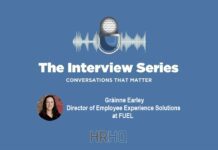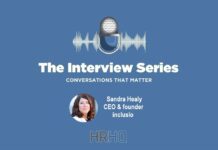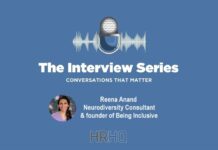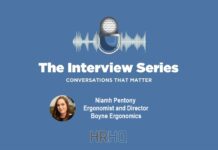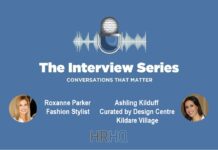by Daniel Williams, Founding Director, Visualise Training and Consultancy
Hearing loss can affect every aspect of a person’s life, but it’s particularly challenging in the workplace. Whether it’s missing out on important information in meetings or struggling with phone calls, hearing loss can create barriers that hinder both professional growth and day-to-day productivity.
The Invisible Barrier
What many people don’t realise is that hearing loss is often invisible. While someone might have difficulty hearing, they may not show any obvious signs. This can lead to misunderstandings, especially when colleagues or managers don’t acknowledge the challenges faced by people with hearing loss. The assumption may be that hearing loss doesn’t impact work unless it’s extremely severe, but even mild to moderate hearing loss can create significant difficulties.
Workplace Communication Struggles
Meetings are often where hearing loss becomes most apparent. Imagine sitting in a room full of colleagues discussing strategies and objectives, but the discussion becomes muffled or hard to follow. The challenge is that people with hearing loss might not always speak up to ask for clarification, especially if they fear being judged or interrupting the flow of conversation.
This can lead to the perception that they aren’t contributing or engaging with the conversation when, in fact, they’re struggling to keep up. A few simple workplace adjustments, like using a microphone in meetings or providing meeting agendas and summaries, can make a significant difference in ensuring clear communication and reducing misunderstandings.
The Importance of Support and Adjustments
Employers have a legal and moral responsibility to accommodate employees with hearing loss. This could mean offering assistive technology like captioning services or ensuring that meetings are accessible with written follow-ups. But it also requires a cultural shift within the workplace, where the value of inclusive communication and the understanding of hearing loss are prioritised.
What Needs to Change?
- Awareness: Employers and colleagues need to be educated about the challenges faced by employees with hearing loss and understand that it’s not just a “personal” issue; it impacts performance, morale, and success.
- Flexibility: Allowing employees to have access to meetings in formats that work for them—whether it’s through captions, transcripts, or sign language interpreters—creates a more inclusive environment.
- Compassion: Creating a workplace culture where people are encouraged to discuss their challenges without fear of judgment is key to making sure everyone has an equal opportunity to succeed.
Hearing Loss Myths That Need to Be Left Behind
There are many misconceptions about hearing loss that have persisted for years, often preventing people from seeking the support they need or perpetuating stigma. Let’s bust some of these myths and look at the truths behind them.
Myth 1: “Hearing Loss Only Affects Old People”
While age-related hearing loss is common, hearing loss can affect people of all ages; more than 5% of the world’s population—approximately 430 million people—suffer from hearing loss. Causes can range from genetics and injury to exposure to loud noises or certain medical conditions. So, don’t assume that hearing loss only happens in later life. It can occur at any stage.
Myth 2: “Hearing Aids Solve Everything”
Hearing aids can help amplify sound, but they’re not a magical fix-all. They don’t restore hearing to normal levels and may not work equally well for everyone. Many people with hearing loss also struggle with background noise, distorted sounds, or hearing in difficult environments, which hearing aids alone can’t always solve. People with hearing loss might also need additional support, like captioning, lip reading coaching, or assistive listening devices.
Myth 3: “People with Hearing Loss Can’t Participate in Conversations”
It’s easy to assume that someone with hearing loss is disconnected from social situations, but many people with hearing loss are perfectly capable of engaging in conversations. With the right tools and strategies, like lip reading or assistive technology, they can follow along and actively participate. The key is communication—finding ways to ensure that the person with hearing loss feels included and understood.
Myth 4: “People with Hearing Loss Are Just Being Rude When They Ask You to Repeat Yourself”
People with hearing loss are often afraid to ask others to repeat themselves because it can feel awkward or frustrating. However, it’s not about being rude; it’s about the need for clarity. People with hearing loss may find it difficult to understand speech in noisy environments or when there’s background chatter. Instead of feeling impatient, be patient and supportive when someone asks for repetition or clarification.
The Social Model of Hearing Loss: Why It’s Not Just About Your Ears
Hearing loss isn’t just about “bad ears.” It’s about the barriers created by society that make it harder for people with hearing loss to engage fully in life. This is where the Social Model of Disability comes in. Instead of seeing hearing loss as a personal deficiency, this model views it as a result of the way society is structured.
What is the Social Model of Disability?
The Social Model of Disability focuses on changing the environment rather than “fixing” the individual. It emphasises the idea that people with hearing loss are disabled not because of their condition, but because of how society doesn’t accommodate them. In this context, hearing loss is not the problem—the problem is the lack of accessible communication, spaces, and services.
Breaking Down Social Barriers
In a world where spoken communication is dominant, people with hearing loss face unique challenges. However, these challenges can be overcome with better access to information, such as captioning in media, better public announcement systems, or more inclusive social spaces. The Social Model stresses that the problem lies in the design of our environments, not the people who navigate them.
Moving Towards an Inclusive Society
The key to an inclusive society is making small changes that benefit everyone. For example, having captions at public events, offering sign language interpreters at conferences, and ensuring workplaces have appropriate accommodations can level the playing field for those with hearing loss. As we move towards a more accessible world, the Social Model of Disability helps shift focus away from what individuals can’t do to what society can do to help everyone thrive.
About the author
Daniel Williams established Visualise Training and Consultancy in 2014 to share his experience and expertise with businesses and organisations to ensure they support their employees with disabilities while meeting their legal obligations under The Employment Equality Act 1998 – 2015.
Visualise Training and Consultancy promotes and enables inclusion, accessibility and equality for people living with visual impairment, hearing loss and other forms of disability.






